Christmas cactus is popularly known as holiday cactus. They brighten up the space in winter with their bloom. They have stem segments, each joined with one another. One must understand its care requirements to have a healthy and happy Christmas cactus.
This guide will help beginners experience plant parents as it is guaranteed that you will learn something from this article.
We have jotted down all the basic requirements and common issues that Christmas cactus face.
Christmas cactus prefers to stay in bright indirect light and warm temperature levels to stay healthy. Water them when the soil is dry from within and maintain average to high humidity around them. You can fertilize them once a week and occasionally spray neem oil to prevent pests and diseases.
You can ace at growing a beautiful Christmas cactus just by understanding their basic requirements.
But what will be more helpful is knowing their issues and potential reasons to follow the prevention than cure rule.
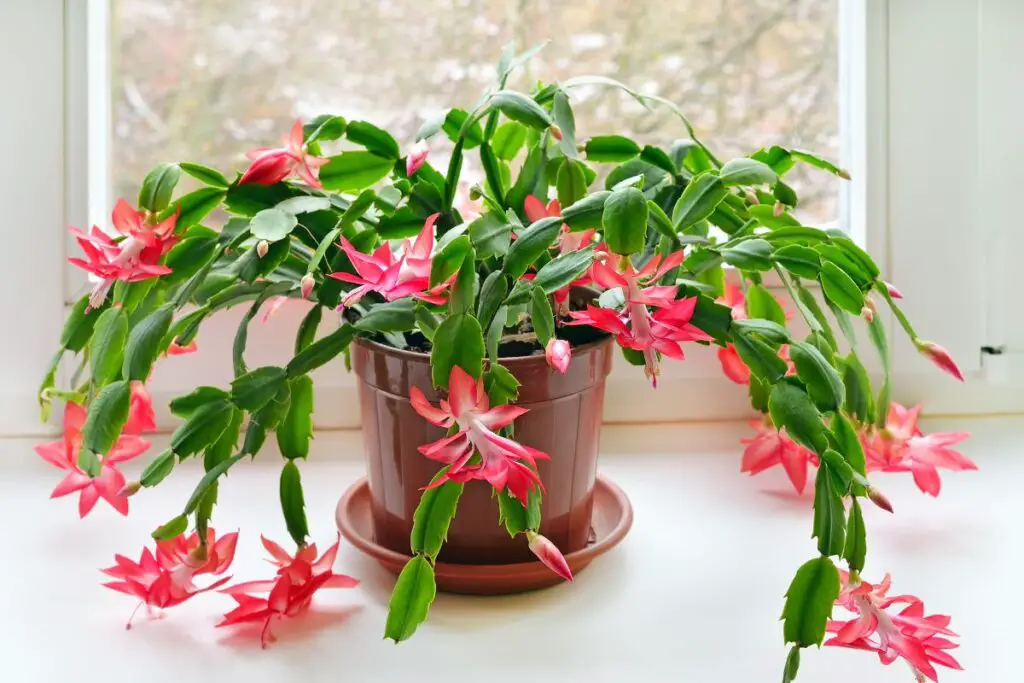
Christmas cactus Overview
The Christmas cactus is native to Brazil and belongs to the cactus family. Even being cactus, they appreciate humid and warm conditions.
They appreciate frequent watering keeping their soil evenly moist between watering.
Christmas cactus has unique looks as one stem segment joins another to form a chain-like structure, which is unusual.
They bloom during the Christmas break, due to which they are famously known as holiday cacti. They need special care from buds and bloom.
The Christmas cactus will grow up to 1 ft high and 2 ft wide when growing indoors. Pruning helps to reduce the weight of the stems on roots and pot.
Are Christmas cactus easy to grow?
Christmas cactus is an easy-to-grow plant but may suffer if unfavorable conditions are consistent. They need some arrangements if you want them to bloom.
You will see your Christmas cactus growing healthy, strong, and blooming for decades with appropriate care and conditions.
Is Christmas cactus indoor or outdoor?
Christmas cactus can be kept both indoor and outdoor but will show better growth and health when grown as indoor plants.
Keeping them indoors is crucial during extreme temperatures.
Christmas cactus-like warm and humid conditions.
Cold and hot drafts and frost may damage the plant severely. They do not like direct harsh light as it burns the stems and damages the plant internally, causing several issues.
Keeping them indoors saves the plant from harsh direct light and temperatures. If you keep the plant in extreme conditions, the plant will suffer and may even die.
Also read: When To Move Christmas Cactus Outside? (What To Consider+How To Move)
Are Christmas cactus poisonous to pets?

Christmas cactus is not poisonous to pets. They are safe to keep around your pets, and they don’t even have sharp edges that can harm pets.
Though this doesn’t mean you can give your pet freedom to feed on the plant. Christmas cactus has fibrous material, which can cause vomiting, diarrhea, nausea, and drooling when ingested.
The pet usually suffers when a large bite has been ingested. If you find your pet suffering, immediately contact a vet.
Keep your Christmas cactus at a safe height so your pets cannot reach the plant.
Keep the plant on a shelf or dining table where your pets cannot reach it. Train your pets not to touch or eat the plants.
Spray cayenne pepper diluted in water on the plant as its spicy taste will make the pets think twice before approaching the plant.
Christmas cactus care
Christmas cacti need appropriate care and consistency to be healthy and stress-free. They have some needs to be taken care of for growing stems and flowers.
They need sufficient light, ideal temperature, humid conditions, proper watering, the right dose of fertilizer, and a light soil mix to grow.
In this article, we will help you understand the soil, water, light, temperature, and other needs of the Christmas cactus plant.
Christmas cactus light requirement
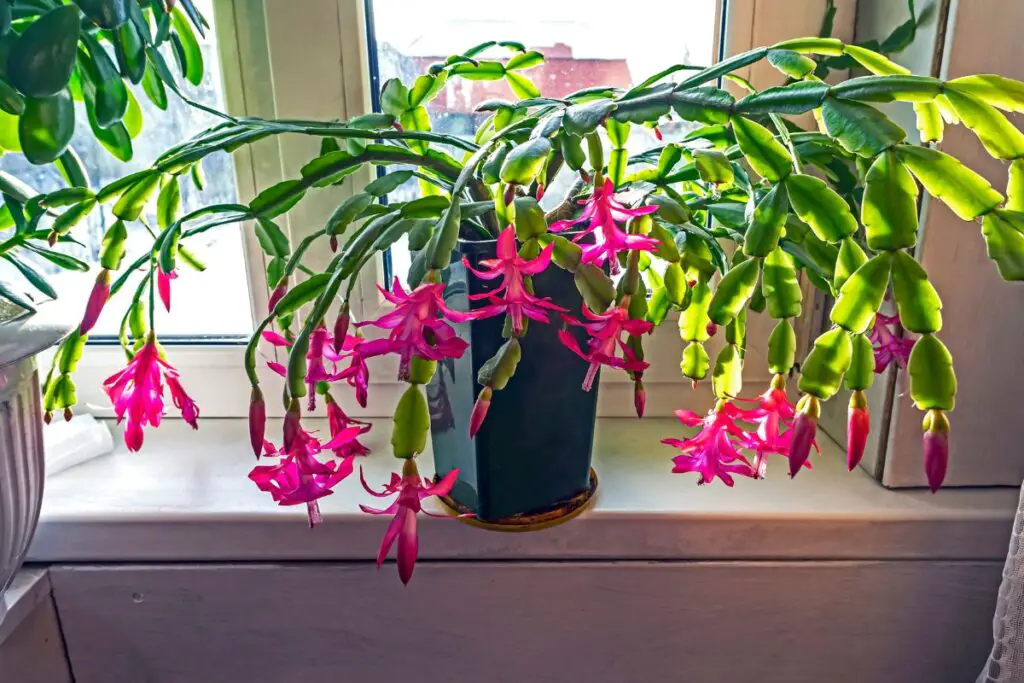
Christmas cactus prefers bright and indirect light. They should not be kept in direct light as it can lead to sunburn.
Though they adapt to various conditions, they will thrive in bright light the most.
If you still want to move them to direct light, do it in winter as the sunlight is not so intense.
During summer, if you keep them outdoors, cast a shade over them or put them on the patio to reduce the intensity of direct light.
They need 6-8 hours of indirect light daily to grow and stay healthy.
You can find the brightest corner or spot in your hope and place your Christmas there.
An East-facing window is a good option for your plant, but ensure there is little or very little direct light on them.
Also read: How Much Light Does My Christmas Cactus Need?
Christmas cactus water requirements
Christmas cactus likes to be watered and stay relatively moist.
It needs less watering when the plant is young and relatively more when it is matured.
The young plant likes to stay dry between watering and moist when they are matured.
You must also ensure the excess water has drained out a few minutes after watering.
Let the water dry before watering the plan to avoid wet conditions in the plant.
The stems will shrivel when the soil is completely dry, which you must take as a sign that your plant needs water.
Even if the soil gets too dry, the plant will stay healthy, but if you overwater them, they will soon die due to root rot.
You must make an effort to check the moisture level of the soil before you decide to water the plant.
Dig your finger in the soil up to 2 inches and take it out to see if the soil is moist or dry from within.
During winters, adjust the watering frequency as the sun is not so intense. It’s best to check the soil’s moistness before watering the Christmas cactus.
Also read: How Often To Water Christmas Cactus? (Water Requirement+Tips)
Christmas cactus soil mix
Christmas cactus can grow in general soil mix as they have no specific requirements.
Though well-draining, aerated soil mix will facilitate better growth and health of the plant and also help avid over the watering condition; thus, we must use well-draining soil mix.
They need soil pH levels between 5.5 and 6.2 to achieve growth and development. Adding organic matter, gravel, etc., is recommended in the soil for drainage and aeration.
To grow your Christmas cactus healthy, you need a well-draining, aerated, organically rich soil mix.
Such soil will retain the required moisture and allow excess water to drain out. Also, it will allow easy flow of water and air, which will keep the roots healthy.
You can prepare the ideal soil mix for your Christmas cactus in the following way:
Recipe 1:
- 1 part regular soil mix
- 1 part organic matter such as peat, perlite
Recipe 2:
- 1 part regular soil mix
- 1 part coarse sand/ aquarium gravel
Also read: What Kind Of Soil Is Best For A Christmas Cactus? (+Best Soil Mix)
Looking for gardening supplies? We have tested 100's of products before recommending them to you guys. Check out our best pick below:
| Image | Gardening Supplies | Best Price? |
|---|---|---|
 Top
Top Top
Top | Raised Garden Bed Kit | Check On Amazon |
 | XLUX Soil Moisture Meter, Plant Water Monitor, Soil Hygrometer Sensor for Gardening, Farming, Indoor and Outdoor Plants, No Batteries Required | No Results |
 Top
Top Top
Top | 82 Pcs Garden Tools Set and Extra Succulent Tools Set | Check On Amazon |
 | Joeys Garden Expandable Garden Hose with 8 Function Hose Nozzle, Lightweight Anti-Kink Flexible Garden Hoses, Extra Strength Fabric with Double Latex Core, (50 FT, Black) | No Results |
 Top
Top Top
Top | Dual Chamber Compost Tumbler | Check On Amazon |
 Top
Top Top
Top | Sunnyglade Plant Stakes | Check On Amazon |
 Top
Top Top
Top | Organic Cold Pressed Neem Seed Oil | Check On Amazon |
 Top
Top Top
Top | Mighty Mint Gallon :-Insect and Pest Control Peppermint Oil | Check On Amazon |
 Top
Top Top
Top | Scotts DiseaseEx Lawn Fungicide | Check On Amazon |
 Top
Top Top
Top | Jacks Classic 20-20-20 All Purpose Fertilizer | Check On Amazon |
 Top
Top Top
Top | 30,000 Seeds Pollinator Attracting Wildflower Mixture | Check On Amazon |
 Top
Top Top
Top | Survival Vegetable Seeds Garden Kit-Over 16,000 Seeds | Check On Amazon |
Christmas cactus fertilizer requirement
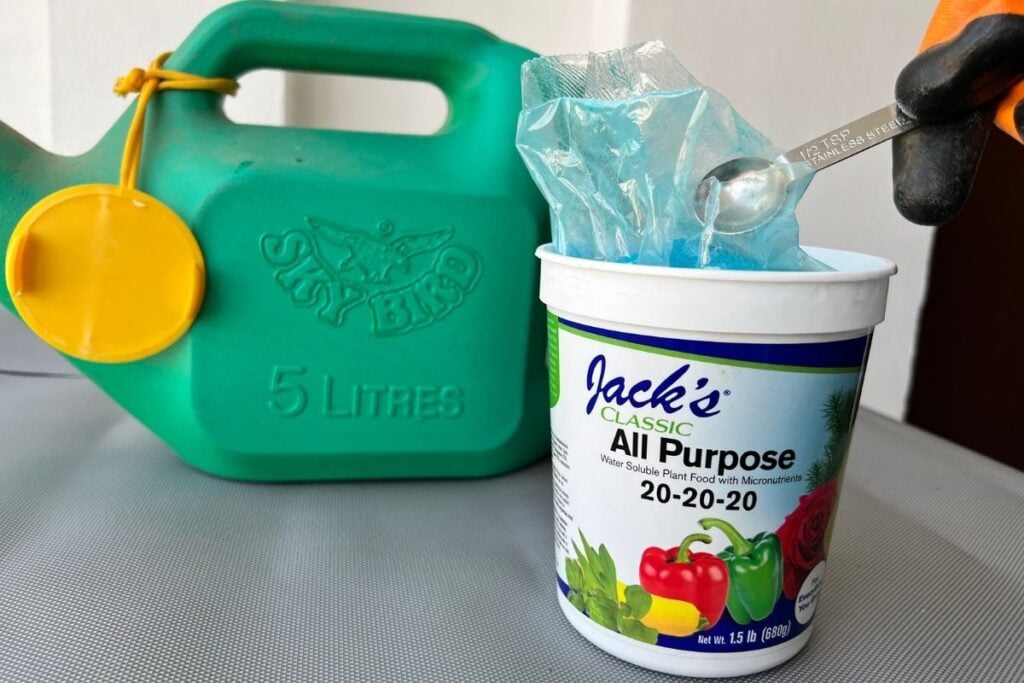
Christmas cacti are light feeders as they grow on the canopy of trees in their native environment.
They need nutrients only when they are growing indoors.
As houseplants, the environmental conditions are limited, and they need more care. Fertilizing is also vital for their growth and blooming.
Fertilizing helps the Christmas cacti to maintain their nutrient requirements and encourage growth.
Balanced houseplant fertilizer diluted in half the recommended strength is good enough for Christmas cactus.
Feed the plant once every two months during the growing season, i.e., from April to September. Do not over-fertilize, as it can stress the plant and affect the plant’s health.
Fertilizing in the growing season is required to allow the plant to form buds and flower during the winter.
Resume fertilizing after the flowering has ended. If you fertilize the Christmas cactus in winter, the plant may not be able to flower due to excess fertilizer and will stunt growth.
Also read: Do Christmas Cactus Need Fertilizer? (How Often+Best Pick)
Temperature tolerance of Christmas cactus
Christmas cactus likes warm temperature levels to thrive, preferably between 70°F and 80°F.
The plant will flourish and bloom if the ideal temperature is maintained.
Temperature is crucial for the Christmas cactus to bloom. During the growing season, they need balmy temperatures, and their temperature requirement changes when winter approaches.
Once the buds form, the Christmas cactus needs low temperatures ranging between 55°F to 65°F.
Along with low temperature, they need 12 hours of darkness daily.
Christmas cactus does not appreciate temperature changes as it may damage the plant and affect blooming.
During blooming, keep the Christmas cactus at 60°F to 65°F. Also, avoid exposing the plant to cold or hot drafts and heating systems.
Humidity for Christmas cactus
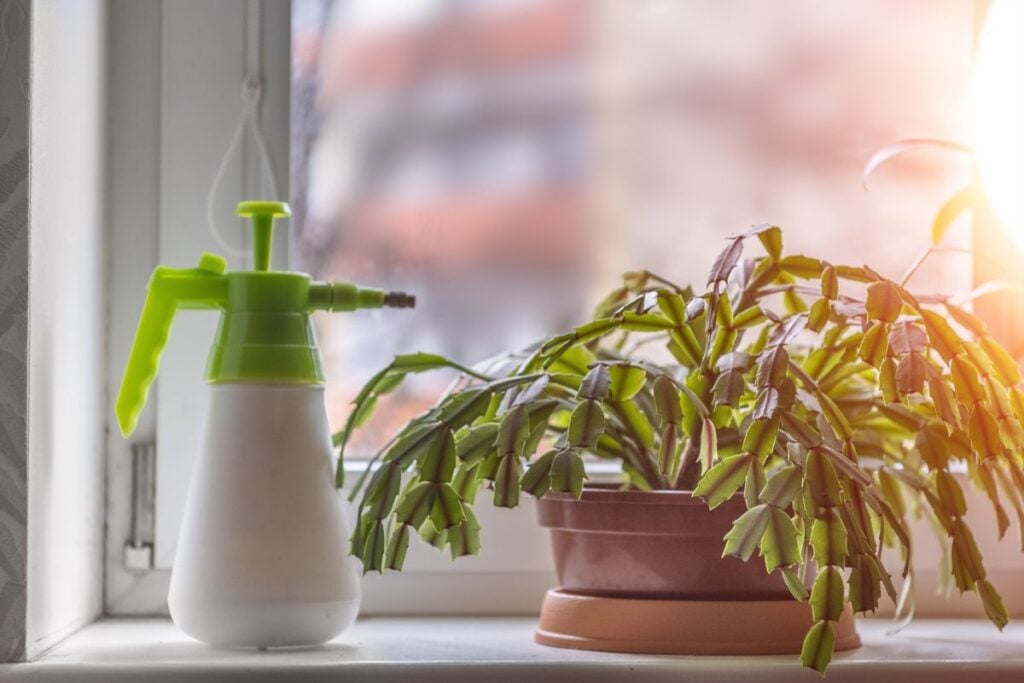
Christmas cactus appreciate a humid environment. That sounds unusual, but Christmas cacti flourish in average to high temperatures.
If you keep your Christmas cactus in humidity between 40% to 60%, they will be more than happy and healthy.
Though some variation in humidity will not affect the plant’s health, if kept in low humidity for a prolonged period, the plant will start suffering.
Due to low humidity, the plant will lose its moisture, and leaves will turn yellow.
They need proper humidity, especially when the air is dry, mainly due to heating systems in winters.
During such time, you can use a humidifier where the plant is kept or mist around the plant to maintain ideal humidity.
Also read: Do Christmas Cactus Like humidity? (Humidity Requirements+Tips To Increase)
Pruning your Christmas cactus
Christmas cactus can become heavier as stems grow longer and create pressure on the roots and pot.
Pruning helps the plant become bushier and maintain weight. Also, it helps avoid leggy growth, removes damaged parts, and encourages new growth.
You can prune the Christmas cactus using sterilized scissors or even your fingers to trim its stem segments. Pruning at the right is equally important; otherwise, the plant’s health may suffer.
Pinch off the stem sections from the top after a month of blooming ends.
Do not prune after late spring as it may affect plant growth. Pruning after the blooming ends will encourage new growth. You can prune them if you find any damaged parts at any time of the year.
You can use the trimmed stems to create more Christmas cactuses. Make sure you are using healthy cuttings. Sterilize the used scissors and wash your hands properly.
Repotting your Christmas cactus
The Christmas cactus is different from other cactuses and likes to stay root-bound.
Unlike other plants, you shouldn’t repot them during spring. Repotting also helps replenish the soil and encourages plant growth.
Repot your Christmas cactus in a 4-5 years gap after the flowering ends in late winter or early spring. Never repot while the plant is blooming actively.
Christmas cactus may also need repotting when it has root rot or pest infestation.
That happens due to overwatering, lack of light, or transferred due to other infested plants.
Repot either when the roots have outgrown their pot or have root rot.
If the plant has root rot, you cannot delay the repotting process as the rot may kill the plant. So make sure you carry out the process gently to decrease the stress on the plant.
Repot your plant in a right-sized pot, i.e., slightly bigger pot than the root ball. Use fresh soil mix and place the plant in the pot.
Water the plant thoroughly to reduce the stress on the plant.
Ensure a proper drainage system in the pot to allow excess water to drain out easily. Keep the plant in bright indirect light to encourage its growth.
Christmas cactus propagation
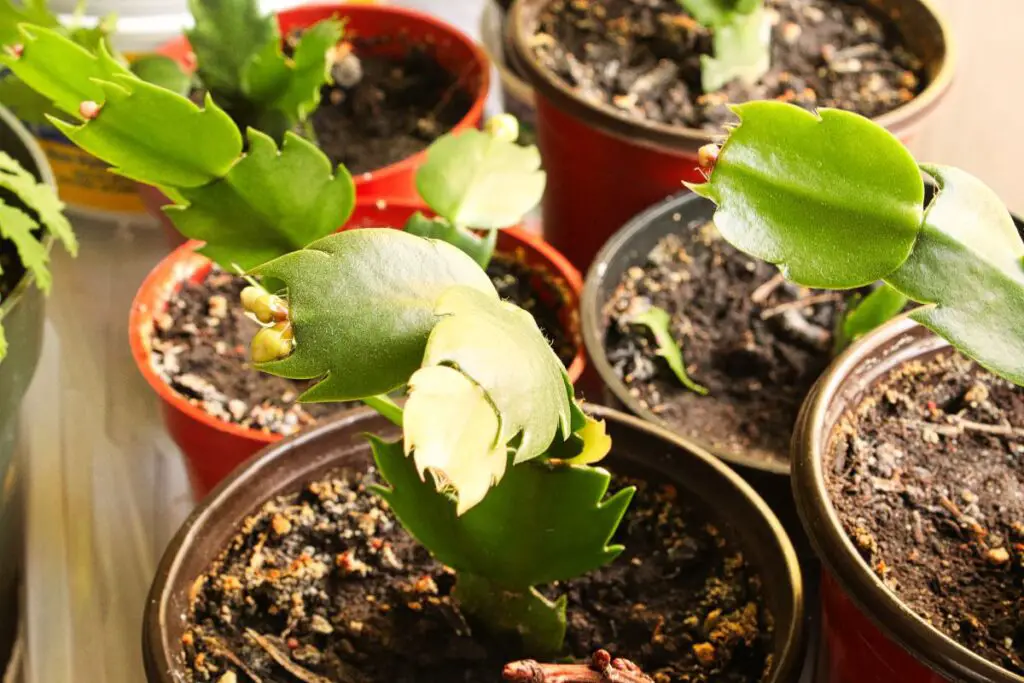
You can propagate your Christmas cactus if your plant is dying or you want to grow more such cactuses.
Propagating to grow new plants is the best thing as it will save money, and you can have as many Christmas cacti as you want.
Take cuttings by pinching the stem section using sharp, sterilized scissors. Take cuttings only from healthy stems.
Keep the cuttings in fresh air to dry. Prepare a glass jar filled with water.
Place the stem inside in such as way that only the base of the stem touches the water. Keep changing the water weekly and keep the plant in bright light.
After one month, the roots may grow. After the roots come out, let them grow for some time, and then plant the cutting in the fresh soil mix.
Also read: How To Propagate Christmas Cactus? (In Water+Soil)
Christmas cactus problems
Christmas cactus may face some problems, which can be due to external or internal issues.
Do not panic because your Christmas cactus is hardy and will come back if you fix the problem on time.
Examine your Christmas cactus every few weeks to ensure they are okay and living in favorable conditions.
Commonly overwatering, low humidity, temperature shifts, etc., affect their health.
Let’s discuss some common problems seen in the Christmas cactus and how you can fix them.
Pests infestation in Christmas cactus
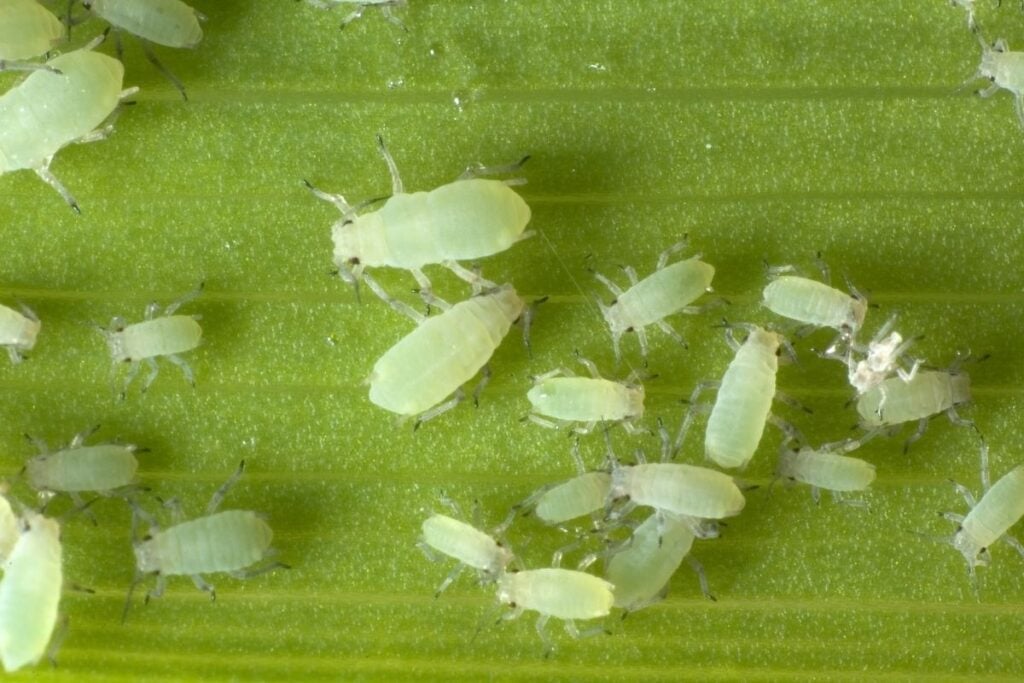
Christmas cactus may look dull when infested with pests. Even the healthiest plant may die when infested with pests.
Pests such as spider mites, mealy bugs, aphids, and gnats infect Christmas cactus.
Signs like brown leaves, yellow leaves, white spots, discoloration, and leaves falling off indicate that the plant may be infested with pests.
These pests keep feeding on the plant-sucking all nutrients and moisture of the plant. The plant gradually becomes weak, dull, and vulnerable, and the growth slows down.
Keep the pest-infested plant away from other plants. Treat the plant using natural remedies such as neem oil solution, horticulture oil, etc.
You can use chemical pesticides to treat the plant but only use them as a last resort. Use the pesticides on your plant according to the instructions.
Also read: How To Get Rid Of Bugs In Christmas Cactus? (Common Bugs+Fix)
Yellow leaves on Christmas cactus
Christmas cactus may exhibit yellow leaves for several reasons like overwatering, lack of light, or lack of nutrients.
Overwatering is the root cause of most of the problems in your plant. It leads to root rot which causes discoloring and yellow leaves.
Lack of light also leads to yellow leaves. Due to low light, the plant cannot photosynthesize, and the leaves become dull and yellow.
A lack of nutrients may lead to a weak and vulnerable Christmas cactus.
If you skip feeding it for a long time, the plant, due to nutrient deficiency, has yellow leaves, leaf drops, etc.
There could be other reasons also such as repotting. If you have recently repotted your Christmas cactus, then it could be the reason. The plant can turn yellow due to transplant stress.
Also read: Why Is My Christmas Cactus Turning Yellow? (Causes+Fix)
Brown leaves on Christmas cactus.

If your Christmas cactus starts turning brown, it indicates that they are suffering from some problem. It could be due to internal factors or external factors.
Possible reasons are overwatering, under watering, low humidity, or pest infestation.
You may even lose your plant if the problem is not identified and treated at the right time.
Overwatering suffocates the roots and hinders water and airflow in the soil and roots. That leads to root rot which leads to brown leaves.
Treat the plant as soon as you have suspected root rot. Take out the plant from the pot to check the roots. If the roots are brown and mushy, then trim them.
Underwatering can also damage the plant slowly, the soil becomes bone dry, and the plant lacks water and nutrients.
The leaves become crisp, dull, and have brown spots due to prolonged dehydration.
Christmas cactus likes humidity, which means the plant tends to suffer if the humidity is low for a long time.
That happens especially during winters when the air is dry, which may be the reason for brown leaves.
Pests suck all the nutrients from the plants and lead to brown spots on the leaves. If not treated on time, it can even kill your Christmas cactus.
Curling leaves on Christmas cactus.
The leaves of the Christmas cactus will start to curl due to temperature shifts, underwatering, and low humidity.
If there is a sudden shift in temperature, your Christmas cactus leaves will start to curl due to stress.
Low humidity can also lead to curling as the plant stays in dry air for a long time.
Dehydration due to underwatering also causes curling leaves, brown spots, and dull leaves.
The plant lacks moisture and nutrients, which can damage the plant severely in the long run.
Examine the plant and, check the problem, treat it accordingly.
Also read: Why Is My Christmas Cactus Leaves Curling? (Causes+Fix)
White spots on Christmas cactus
Christmas cactus may have white spots on its leaves due to several reasons.
But the most common causes include direct light and fungal diseases. They get sunburn when kept in the direct light for a long time.
And if left unnoticed, the sunlight scorches their stems which then become white.
Sunburnt Christmas cactus have scorched leaves on the top, and leaves below will be unaffected as the light they receive is filtered.
Prune the damaged, sunburnt leaves as they will only use up the plant’s energy and not recover.
Place the plant in a shaded area where it can receive bright, indirect light.
If the plant is suffering from fungal diseases, you will notice a white and powdery substance on the stems of the Christmas cactus.
Overwatering promotes and leads to such conditions. Avoid keeping them in damp conditions or compact areas.
Use neem oil spray to remove mildew infection and keep the plant in good airflow. It will also let the plant dry easily and recover faster.
Loss of leaves on Christmas cactus
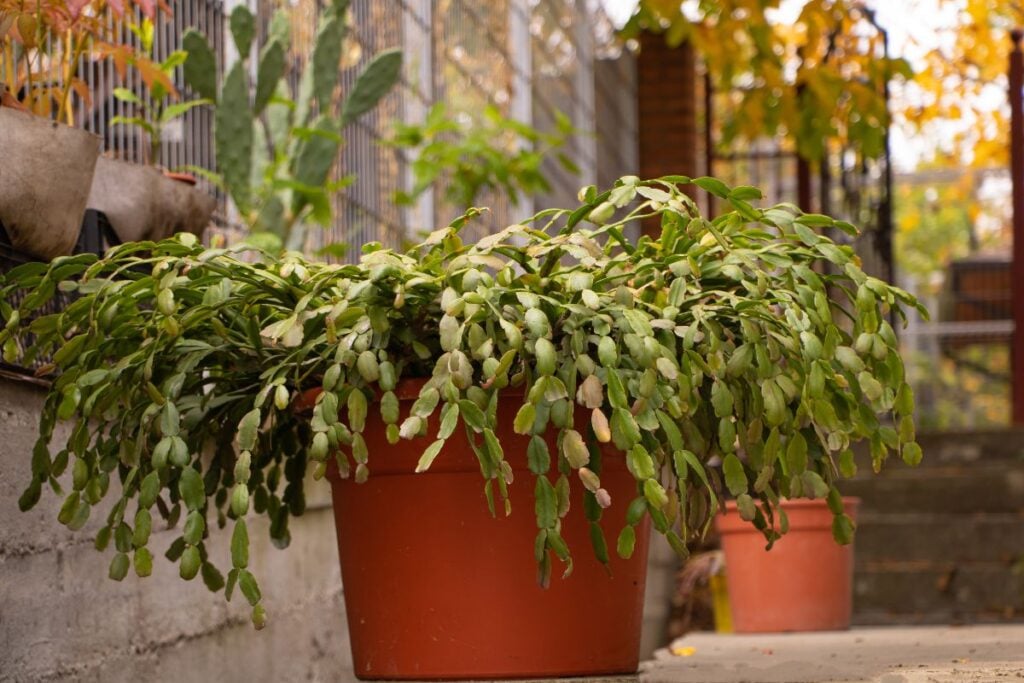
When your Christmas cactus loses its leaves, it can be stressful for the planters. The reason could be improper watering, temperature shifts, etc.
If you keep your plant where the temperature keeps changing, then the plant may start losing its leaves due to temperature stress.
Underwatering Christmas cacti can also lead to the loss of leaves. Due to underwatering, the plant is dehydrated, making the plant weak.
Also, keeping the plant exposed to cold drafts, hot drafts, or other heating systems will lead to the loss of leaves.
Keep the plant in indirect bright light at a regulated temperature.
You should maintain temperature and humidity levels to avoid stress in your Christmas cactus.
Water Christmas cactus to keep its soil moist but not soggy. Do not dry out its soil; water only after checking the soil moisture.
The plant can also lose its leaves due to aging, or the older leaves may drop. If that is the case, then you can stay calm.
Also read: Why Is My Christmas Cactus Dropping Leaves? (Problems+Fix)
Droopy leaves on Christmas cactus
Droopy leaves of the Christmas cactus indicate the dry condition of the plant.
The plant has been kept under-watered for a consistent period, due to which the entire plant has become dry.
Water the plant thoroughly to regain its moisture level. The droopy leaves will be corrected after some time of watering the plant.
Do not skip watering, and keep the plant in good airflow.
Water the plant at regular intervals, makings sure the plant is neither overwatered nor underwater.
Leggy Christmas cactus
If your Christmas cactus is getting leggy, the potential reasons are lack of light, insufficient food, and no pruning.
Lack o light is the most common reason which leggy growth in Christmas cactus.
Due to the lack of light availability, the plant becomes weak and stretches towards little light available.
You need to provide it with ample indirect bright light for 6-8 hours daily. If you lack natural light in your home, you can use an artificial light source to combat the lack of light.
Sometimes, the plant becomes weak and leggy due to a lack of food. They need sufficient nutrients to grow healthy and fuller.
Feed Christmas cactus with diluted houseplant food once every two months in the growing season.
Prune Christmas cactus one month after the blooming ends, i.e., in the early spring. That will keep the plant in good shape, promote new growth and prevent legginess.
Also read: Why Is My Christmas Cactus Leggy? (+How To Make It Bushy)
Root rot in Christmas cactus
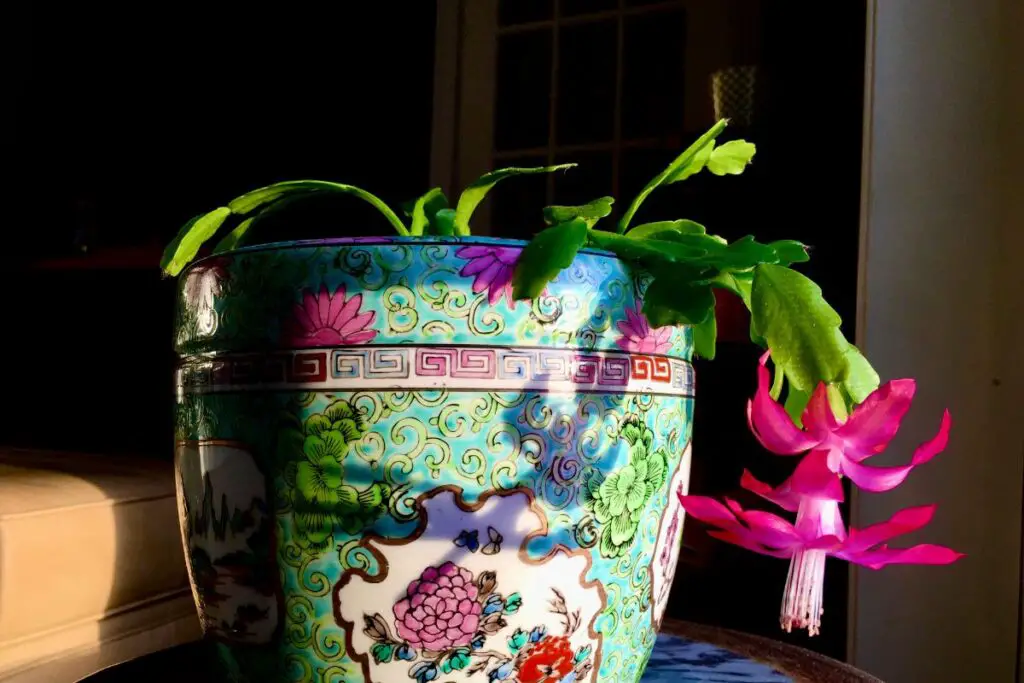
Root rot is caused due to overwatering, and if not treated, it may kill your Christmas cactus.
Overwatering chokes the soil and roots, making it harder for the air and water to flow around the plant.
The roots become weak, brown, mushy, and lose their strength. Root rot damages the entire plant gradually as the plant cannot absorb nutrition and water from soil and roots.
Take the plant gently out of the pot, trim the damaged roots and discard damaged roots, soil, and mushy parts of the plant.
Repot the plant in fresh soil mix in the new post to make sure the plant is safe from fungal infection in the future.
If the condition is severe, then you may have to discard the plant. You can take healthy cuttings from the plant and propagate them o grow Christmas cacti.
Also read: Root Rot In Christmas Cactus? (Signs, Causes & Fix)
My Christmas cactus is not growing.
If your Christmas cactus has stopped growing or is growing very slowly, you must check the plant closely for potential problems.
The plant may stop growing due to a lack of light.
Poor lighting conditions make the plant weak and vulnerable. They cannot carry out the photosynthesis process, due to which the plant’s growth slows down.
Also, a lack of nutrients may lead to slow growth in the Christmas cactus.
Feed the plant with diluted houseplant food once every two months in the growing season to fulfill its nutrient needs.
During winter, the plant may not show much natural growth.
My Christmas cactus is leaning.
Christmas cactus becomes limp due to lack of light. The stems lean towards any light available for them, making them look lean.
Lack of water also leads to the leaning of stems. They need proper watering to stay healthy and plump.
Water the plant thoroughly and let the excess water drain out from the drainage system. Water the plant by checking the soil to ensure the soil is dry and needs water.
Also, keep the plant in proper lighting. If there is a lack of light, use an artificial light source.
Rotate the plant every few days to ensure all parts of the plant are receiving light.
My Christmas cactus is dying.
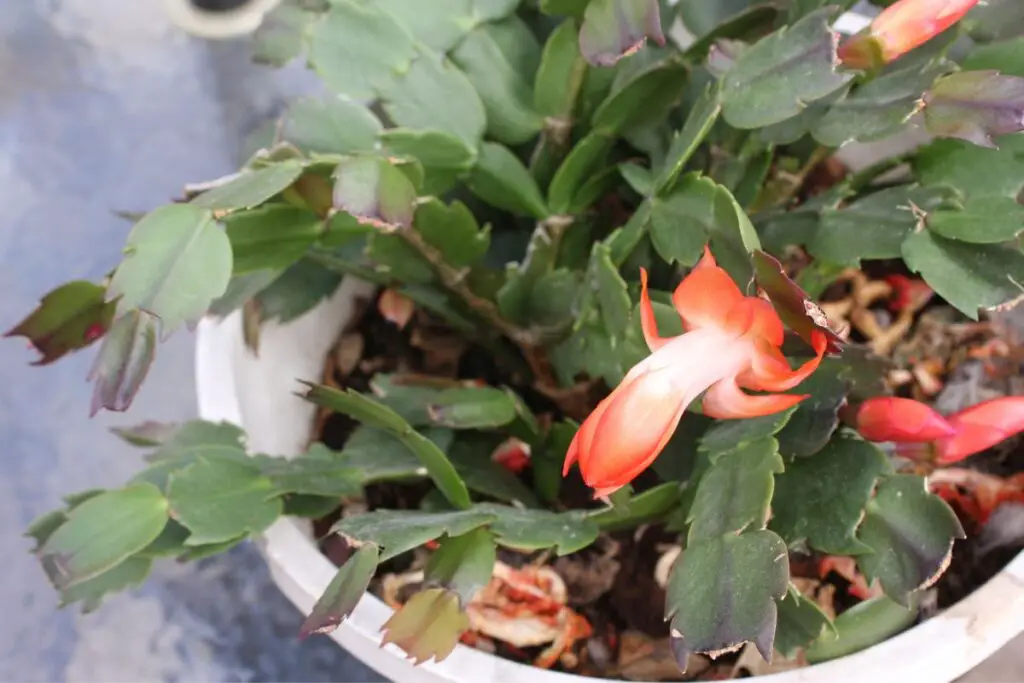
Christmas cactus may look dull and unhappy due to stress, but that does not mean it is dying. It is important to look for the potential reasons by closely examining the plant.
The best way to save your plant from any problem is by regularly examining the plant and taking proper care of your plant.
That will prevent any problem, and even if any problem comes up, you will notice the problem in its initial stages.
Never overwater or underwater your Christmas cactus, and provide water only when the soil is dry from within.
Fertilize the plant in the growing season and avoid over-fertilizing in any condition.
Keep the plant in good lighting, and regulate temperature and humidity levels. It will keep your plant healthy.
Also read:
- Why Is My Christmas Cactus Dying? (Causes+How To Fix)
- How To Save A Dying Christmas Cactus? (A Complete Guide)
Christmas cactus care tips
Christmas cactus will grow and bloom for decades if proper care is taken.
To keep your Christmas cactus healthy and happy, you must understand its ideal demands.
Light: Christmas cacti need 6-8 hours of indirect bright light daily. You can either place them in a spot where they can receive such light or use an artificial light source to fulfill its light requirements.
Water: Water your Christmas cactus thoroughly when the soil is dry. Avoid following any watering routine blindly and check the soil from within before watering.
Soil: Christmas cactus thrives in a well-draining, light, and porous soil mix. It allows easy flow of air and water.
Temperature: Christmas cactus likes temperatures between 65°F to 85°F. Maintain the ideal temperature around your plant and avoid keeping the plant where temperature shifts frequently.
Humidity: Christmas cactus likes average to high humidity. Use a humidifier when the humidity level is low to maintain ideal humidity around the plant.
Fertilizer: Christmas cactus is a light feeder. They need fertilizer during the growing season to stay healthy.
Feed with diluted houseplant food from spring through September. Avoid fertilizing from October to March.
Pruning: Christmas cactus should be pruned to promote new growth.
Pruning at the right time is equally important. Prune it in the early spring to give it a good shape and promote growth.
Repotting: Christmas cactus likes to stay root-bound. Repot the plant in 4-5 years and not before that.
After repotting, provide your plant with proper care and conditions. It will help the plant combat any stress rapidly.
Propagation: Propagation is useful if your plant is dying or you want more Christmas cacti.
Take a healthy cutting and place it in a glass water-filled glass jar. After the roots have grown, plant the cutting in the fresh soil mix.
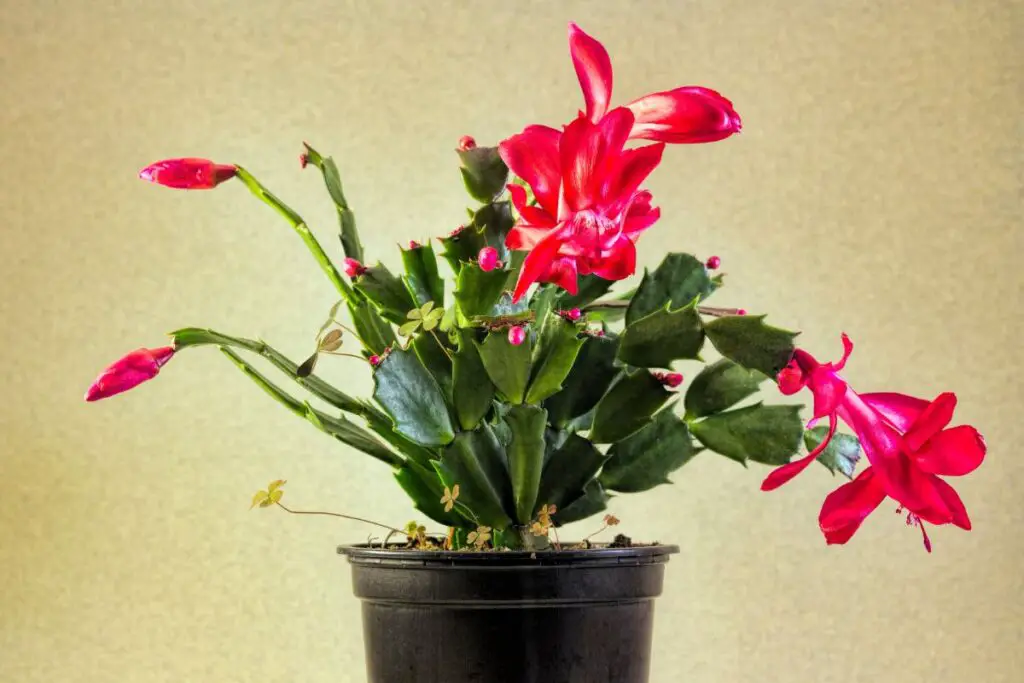
FAQ
How much light does a Christmas cactus need?
Christmas cactus need 6-8 hours of indirect bright light in a day to grow and develop rapidly.
Place it near a window or balcony where it can receive sufficient light. Avoid keeping it in direct harsh light.
Can Christmas cactus cause allergies?
Christmas cactus is not toxic, but if pets or children ingest a large bite.
The pets and children may suffer from vomiting, drooling, diarrhea, and irritation. Take the pet to the vet immediately.
How do I make a Christmas cactus shiny?
Keep your Christmas cactus in bright indirect light. Regulate the temperature level around them and average to high humidity.
Clean the stems regularly to keep them healthy and shiny. That will keep the Christmas cactus healthy, shiny, and plump.
Reference: NC State University, Nebraska Extension in Lancaster County, Researchgate, Texas A&M University, Chicago Botanic Garden.
